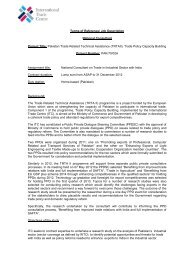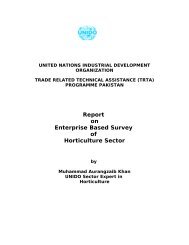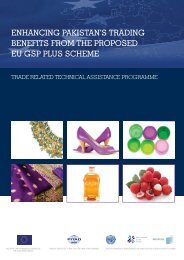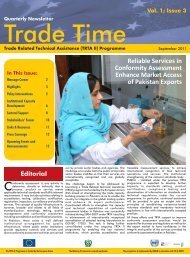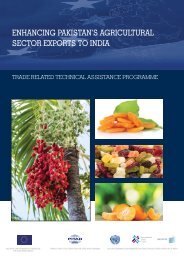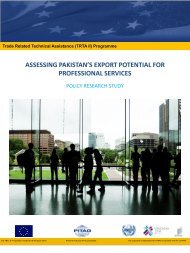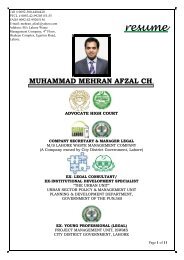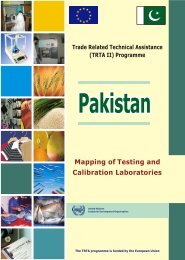Enhancing dairy sector export competitiveness - International Trade ...
Enhancing dairy sector export competitiveness - International Trade ...
Enhancing dairy sector export competitiveness - International Trade ...
Create successful ePaper yourself
Turn your PDF publications into a flip-book with our unique Google optimized e-Paper software.
ENHANCING DAIRY SECTOR EXPORT COMPETITIVENESS IN PAKISTANThe above three types of producers raise milch animals mainly on agricultural lands which is spread overan area of 263,000 sq. Km. Almost one-fifth of this land is being used as pasture land to raise livestockincluding milch animals 20 . The small scale subsistent farmers mainly raise animals on lands which are notproper farmlands and lack many facilities such as access to fodder, grazing grass and availability wateretc. Medium and large-scale producers are mostly located near the urban and peri-urban areas. They haverelatively better access to the above stated facilities. Besides, due to their close proximity with theconsumer markets, they enjoy a better supply chain and organized distribution system.Nutritional FeedThe feed that is available for the livestock in Pakistan includes fodder (dry and green crops/roughage),concentrate feeds, silage and mineral mixtures. The animals require a balanced diet to keep good healthand produce milk as per required yield levels. However, since a major portion of milch animals are bred bysubsistent landless farmers, the nutritional requirements are not fully met. The main reasons are lowerlevels of awareness on feed requirements, disinterest on part of farmers to enhance milk yield and last butnot least, the low economic conditions of the farmers who have limited access to proper feed. The feedprovided to these animals includes fodder mainly grown in limited quantities by these farmers or procuredfrom the local markets.On the other hand, increase in overall demand for appropriate fodder has stimulated the growth of bettercrops such as oats, berseem, lucerne, sorghum-sudangrass, mott grass, sorghum, maize and millet. Thepopular types of dry roughage/ fodder include wheat straw, rice straw, oats straw, maize-sorghum stubble,sugarcane bagasse, cottonweed hulls and corn cobs 21 .Concentrate feed ideally make up about one third of the animals’ daily dietary intake along with two thirdsof Crop Silage 22 .The concentrates include blends of various raw materials and additives that are made forspecific dietary requirements (protein, energy, vitamins or minerals) of the animal. In Pakistan, mostly theSilage 23 is produced from corn crop whereas this can be prepared by using any crop which helps inincreasing the productivity of milch animals. To reduce input costs for the farmers, the Government ofPakistan has introduced duty-free import of certain feed ingredients, growth promoters and vitaminpremixes into the country 24 .Herd MixAmongst the common breeds, Nili Ravi and Kundi are the best milch buffalo breeds in Pakistan. Nili Ravi ismostly found in Punjab’s districts of Lahore, Sheikhupura, Faisalabad, Sahiwal, Multan and Bahawalnagar.These black colour breeds have average weight of 800 kg at maturity for male and 525 kg for the female[SMEDA (2011)]. They have a wedge shape, massive frame, small curly horns, and wall eyes. They oftenhave white markings on the forehead, face, muzzle and legs and white switch of tail (buffaloes with suchmarkings highly desired and popularly called "Panj Kalian"). They have a large, strong udder and aregenerally docile 25 .The Kundi breed is mostly found in Sindh’s districts of Dadu, Hyderabad, Karachi, Larkana, Nawabshah,Sanghar and Thatta located. They have solid black colour with an average weight at maturity for the malebeing 600 kgs and 375 kgs for the female. The purchase price of a buffalo in second lactation on averageis Rs 90,000 [SMEDA (2011)].Figure 5 contains list of local breeds in Pakistan raised and bred in various parts as explained above.20 Food and Agriculture Organization (FAO) Statistics, 200921 SMEDA22 Ibid23 Silage is a fermented fodder, containing high levels of moisture that can be fed to cud-chewing animals like cows, buffaloes, sheepetc. The fodder is made by cutting the green plants and storing then in a silo, making a huge heap and covering it in a plastic sheet orby wrapping large bales of the same in plastic film.24 Economic Survey of Pakistan 2011-12, Chapter 2, Agriculture25 SMEDA26



